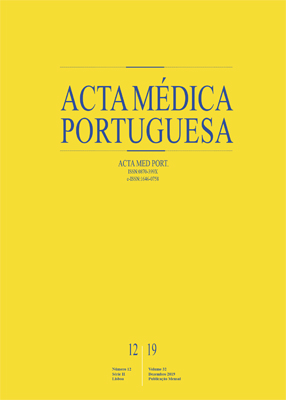Intrathecal Baclofen Infusion Pumps in the Treatment of Spasticity: A Retrospective Cohort Study in a Portuguese Centre
DOI:
https://doi.org/10.20344/amp.10482Keywords:
Baclofen/administration & dosage, Baclofen/therapeutic use, Infusion Pumps, Implantable, Muscle Spasticity/drug therapyAbstract
Introduction: Spasticity is a complex problem in patients with neurological disorders and may distress their quality of life. Intrathecal baclofen infusion pumps reduce spasticity with low doses and minimal side effects but are not free from complications. We aimed to evaluate the efficacy and safety of intrathecal baclofen infusion pumps as well as patients’ satisfaction.
Material and Methods: Retrospective cohort study including all intrathecal baclofen infusion pumps placed up to December 2015. Demographic characteristics, clinical diagnoses, date of placement or withdrawal/replacement of intrathecal baclofen infusion pumps, baclofen dosage and complications of intrathecal baclofen infusion pumps were collected. Assessments from the Ashworth and Penn’s scales, Katz index and patients’ global satisfaction were analysed.
Results: In 19 years we placed 251 intrathecal baclofen infusion pumps in 155 patients. The mean age was 41.1 ± 15.8 years. The most frequent conditions were: trauma (34%), cerebral palsy (14%), multiple sclerosis (12%) and stroke (12%). Eighty-five patients (55%) required a second pump, and eleven (7%) a third one. The lifetime of the first pump was 72 (36 – 89) and the total follow-up time was 96 (9 – 132) months. The causes of withdrawal/replacement were: battery failure (57%), catheter migration/kinking (24%), infection (14%) and pump displacement/exteriorization (7%). The complication rate was 0.21 events/month. There was a significant improvement in the Ashworth and Penn’s scales after the placemen of intrathecal baclofen infusion pumps (p < 0.001 for all diagnoses) and the patients were satisfied with the treatment.
Discussion: The incidence of complications was within range of other international studies despite our long follow-up time. Events per month, loss to follow-up, re-intervention rate, incidence of infection and mortality were similar to other studies.
Conclusion: Intrathecal baclofen infusion pumps are safe and effective in the treatment of spasticity. Infusion pumps provide a high level of satisfaction regarding treatment and quality of life.
Downloads
Downloads
Published
How to Cite
Issue
Section
License
All the articles published in the AMP are open access and comply with the requirements of funding agencies or academic institutions. The AMP is governed by the terms of the Creative Commons ‘Attribution – Non-Commercial Use - (CC-BY-NC)’ license, regarding the use by third parties.
It is the author’s responsibility to obtain approval for the reproduction of figures, tables, etc. from other publications.
Upon acceptance of an article for publication, the authors will be asked to complete the ICMJE “Copyright Liability and Copyright Sharing Statement “(http://www.actamedicaportuguesa.com/info/AMP-NormasPublicacao.pdf) and the “Declaration of Potential Conflicts of Interest” (http:// www.icmje.org/conflicts-of-interest). An e-mail will be sent to the corresponding author to acknowledge receipt of the manuscript.
After publication, the authors are authorised to make their articles available in repositories of their institutions of origin, as long as they always mention where they were published and according to the Creative Commons license.









